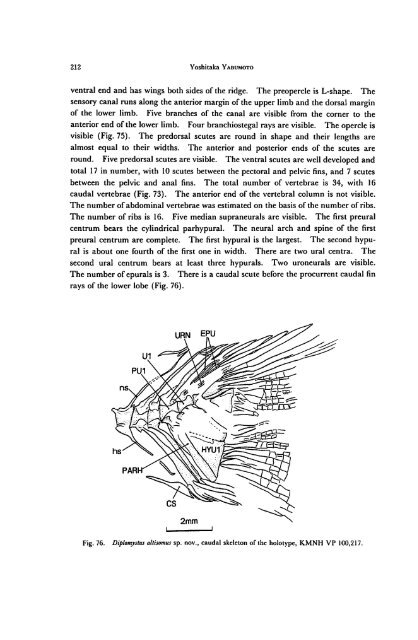Early Cretaceous Freshwater Fish Fauna in Kyushu, Japan
Early Cretaceous Freshwater Fish Fauna in Kyushu, Japan
Early Cretaceous Freshwater Fish Fauna in Kyushu, Japan
You also want an ePaper? Increase the reach of your titles
YUMPU automatically turns print PDFs into web optimized ePapers that Google loves.
212 Yoshitaka Yabumoto<br />
ventral end and has w<strong>in</strong>gs both sides of the ridge. The preopercle is L-shape. The<br />
sensory canal runs along the anterior marg<strong>in</strong> of the upper limb and the dorsal marg<strong>in</strong><br />
of the lower limb. Five branches of the canal are visible from the corner to the<br />
anterior end of the lowerlimb. Four branchiostegal rays are visible. The opercleis<br />
visible (Fig. 75). The predorsal scutes are round <strong>in</strong> shape and their lengths are<br />
almost equal to their widths. The anterior and posterior ends of the scutes are<br />
round. Five predorsal scutes are visible. The ventral scutes are welldeveloped and<br />
total 17 <strong>in</strong> number, with 10 scutes between the pectoral and pelvic f<strong>in</strong>s, and 7 scutes<br />
between the pelvic and anal f<strong>in</strong>s. The total number of vertebrae is 34, with 16<br />
caudal vertebrae (Fig. 73). The anterior end of the vertebral column is not visible.<br />
The number ofabdom<strong>in</strong>al vertebrae was estimated on the basis of the number of ribs.<br />
The number of ribs is 16. Five median supraneurals are visible. The first preural<br />
centrum bears the cyl<strong>in</strong>drical parhypural. The neural arch and sp<strong>in</strong>e of the first<br />
preural centrum are complete. The first hypural is the largest. The second hypu<br />
ral is about one fourth of the first one <strong>in</strong> width. There are two ural centra. The<br />
second ural centrum bears at least three hypurals. Two uroneurals are visible.<br />
The number of epurals is 3. There is a caudal scute before the procurrent caudal f<strong>in</strong><br />
rays of the lower lobe (Fig. 76).<br />
Fig. 76. Diplomystus altisomus sp. nov., caudal skeleton of the holotype, KMNH VP 100,217.

















